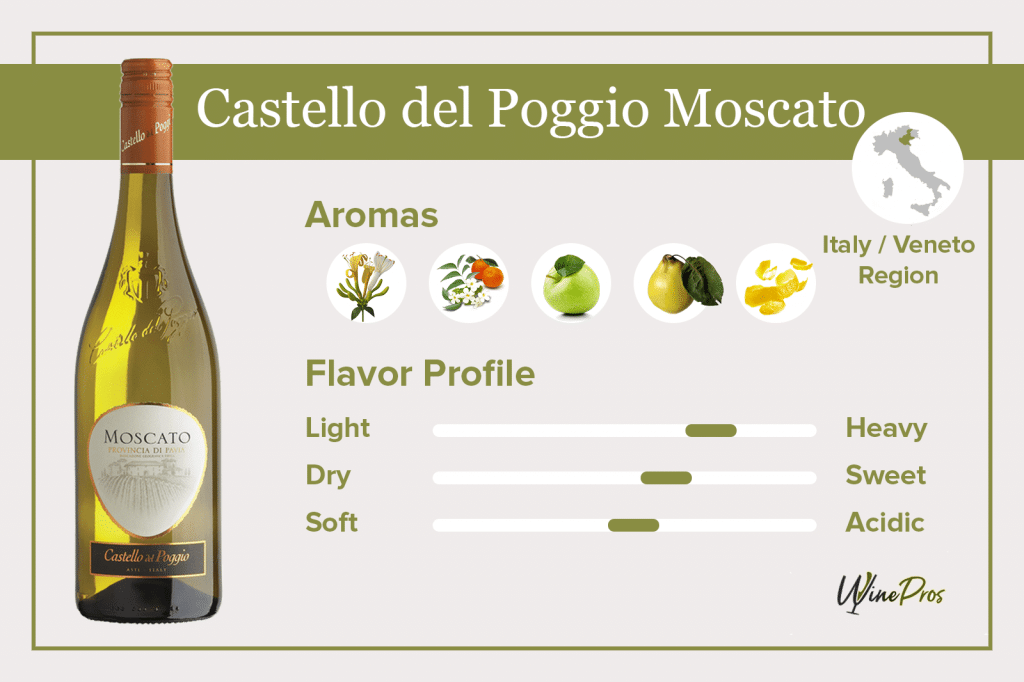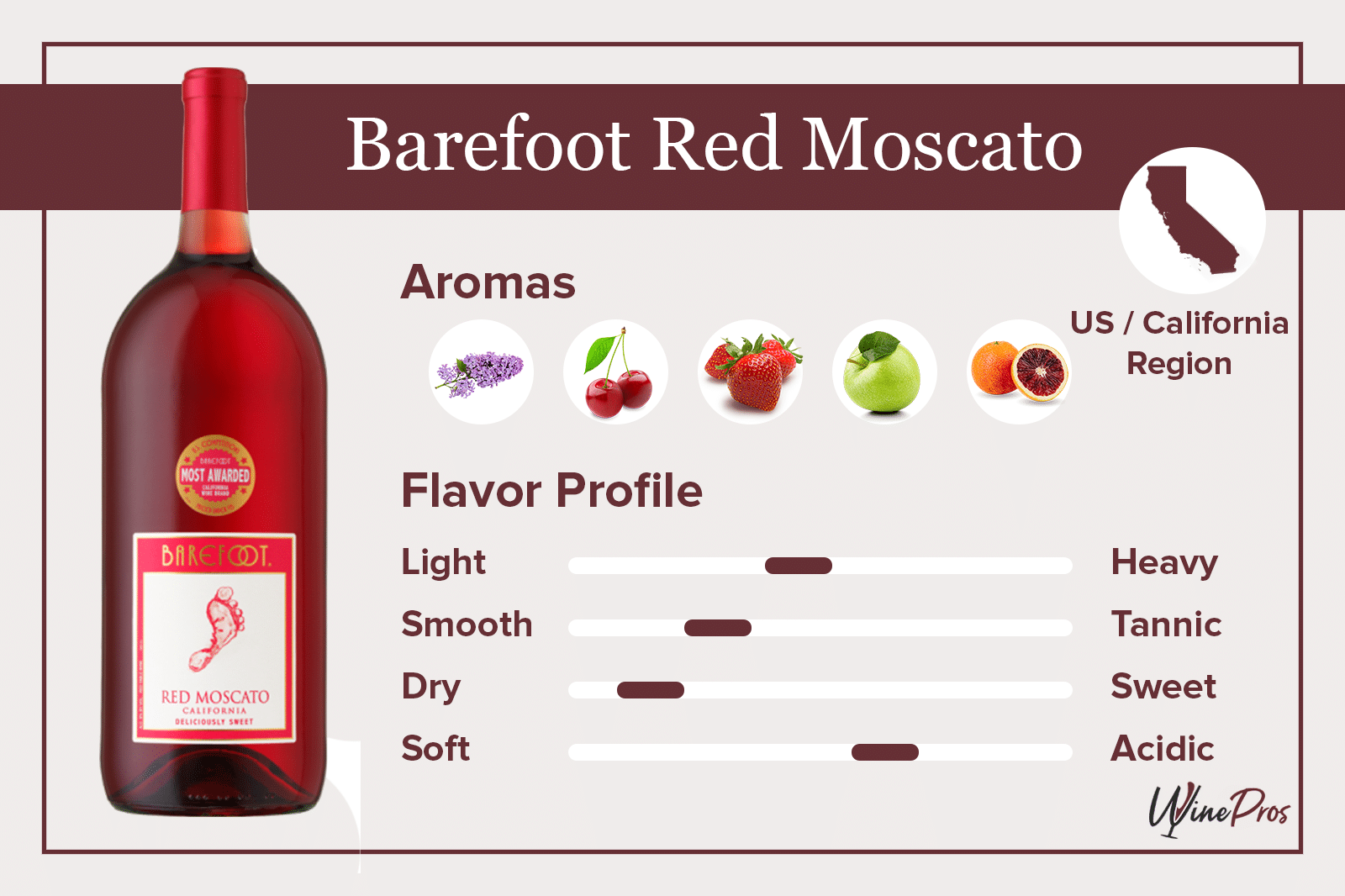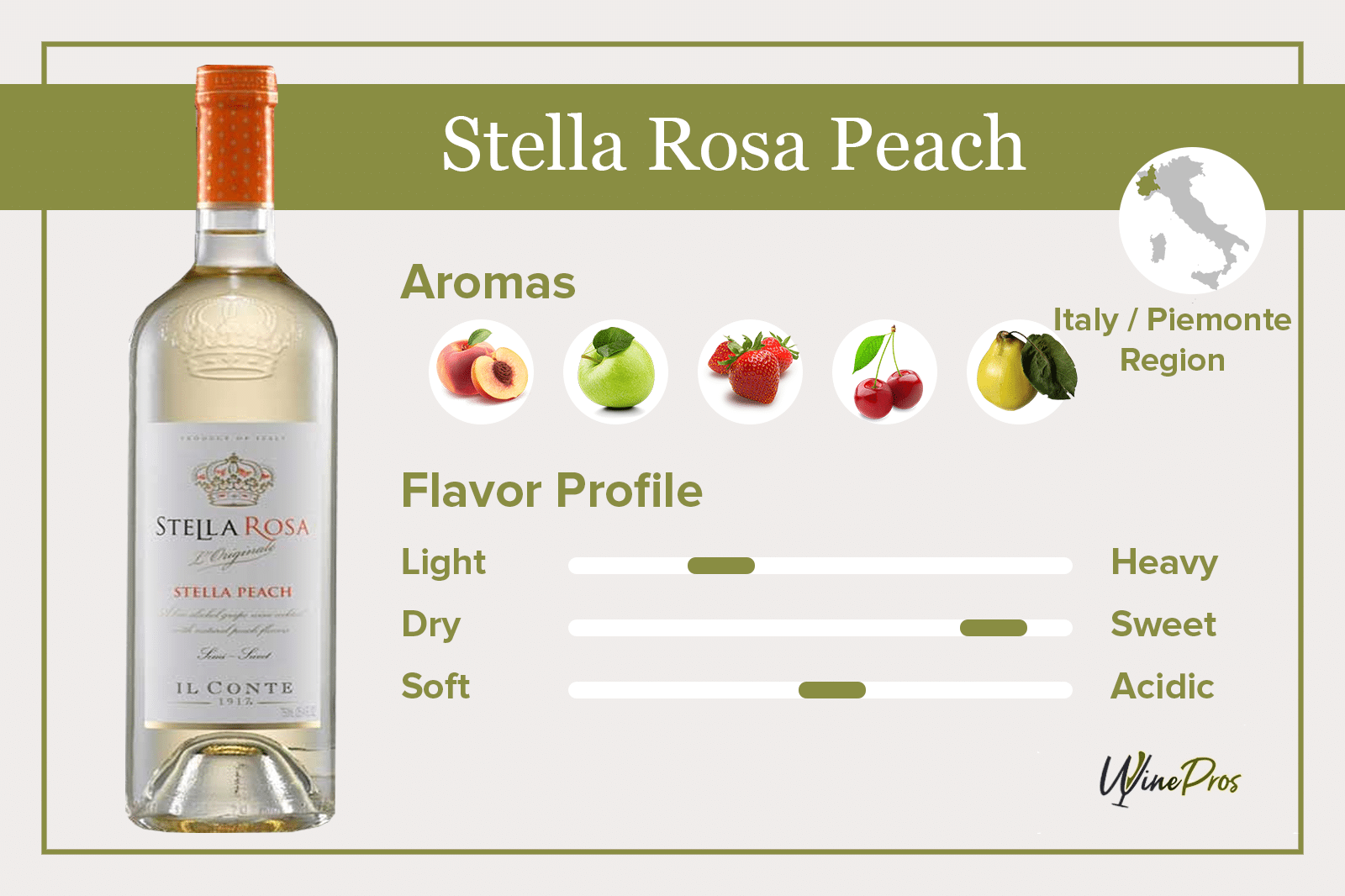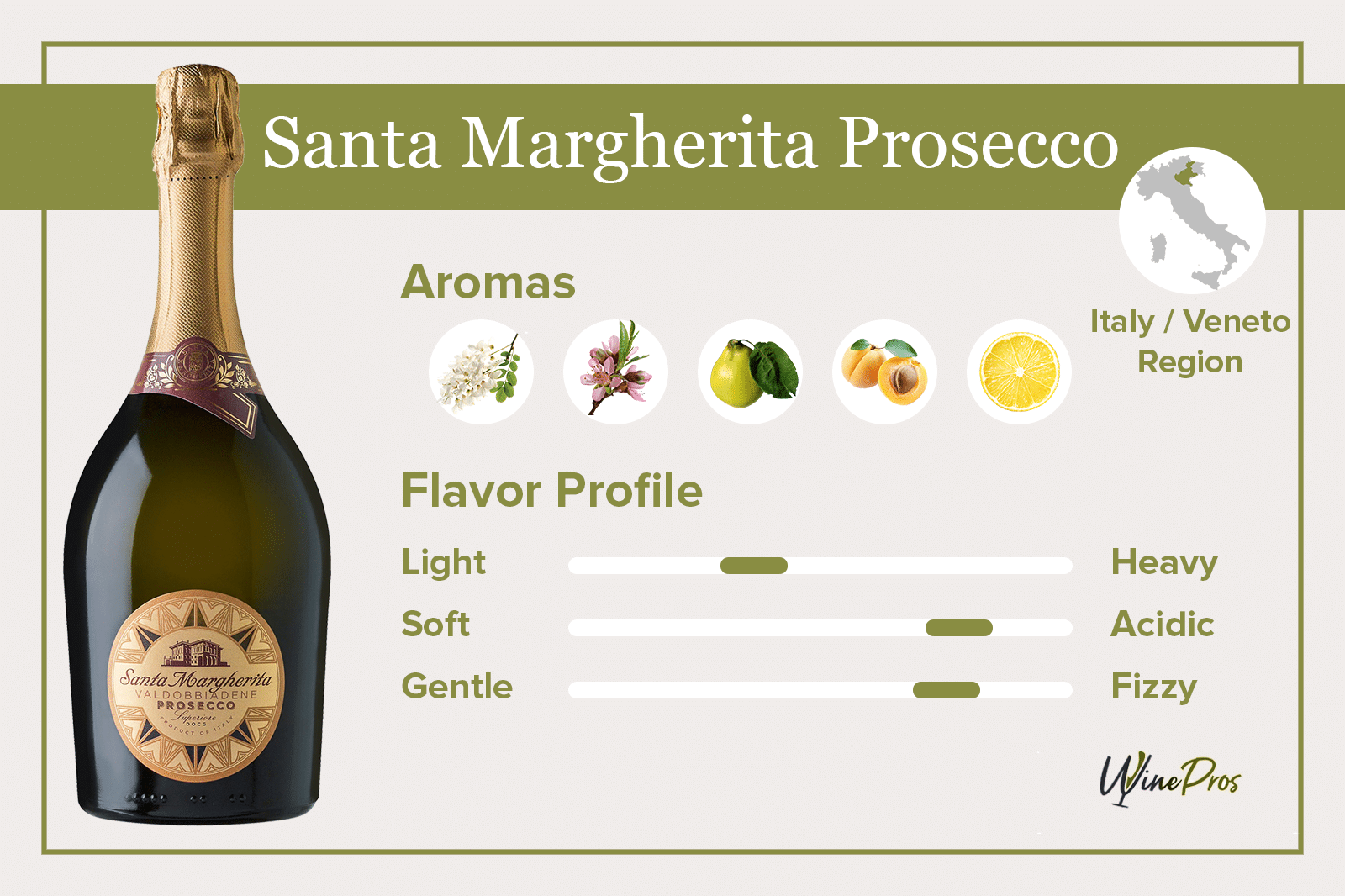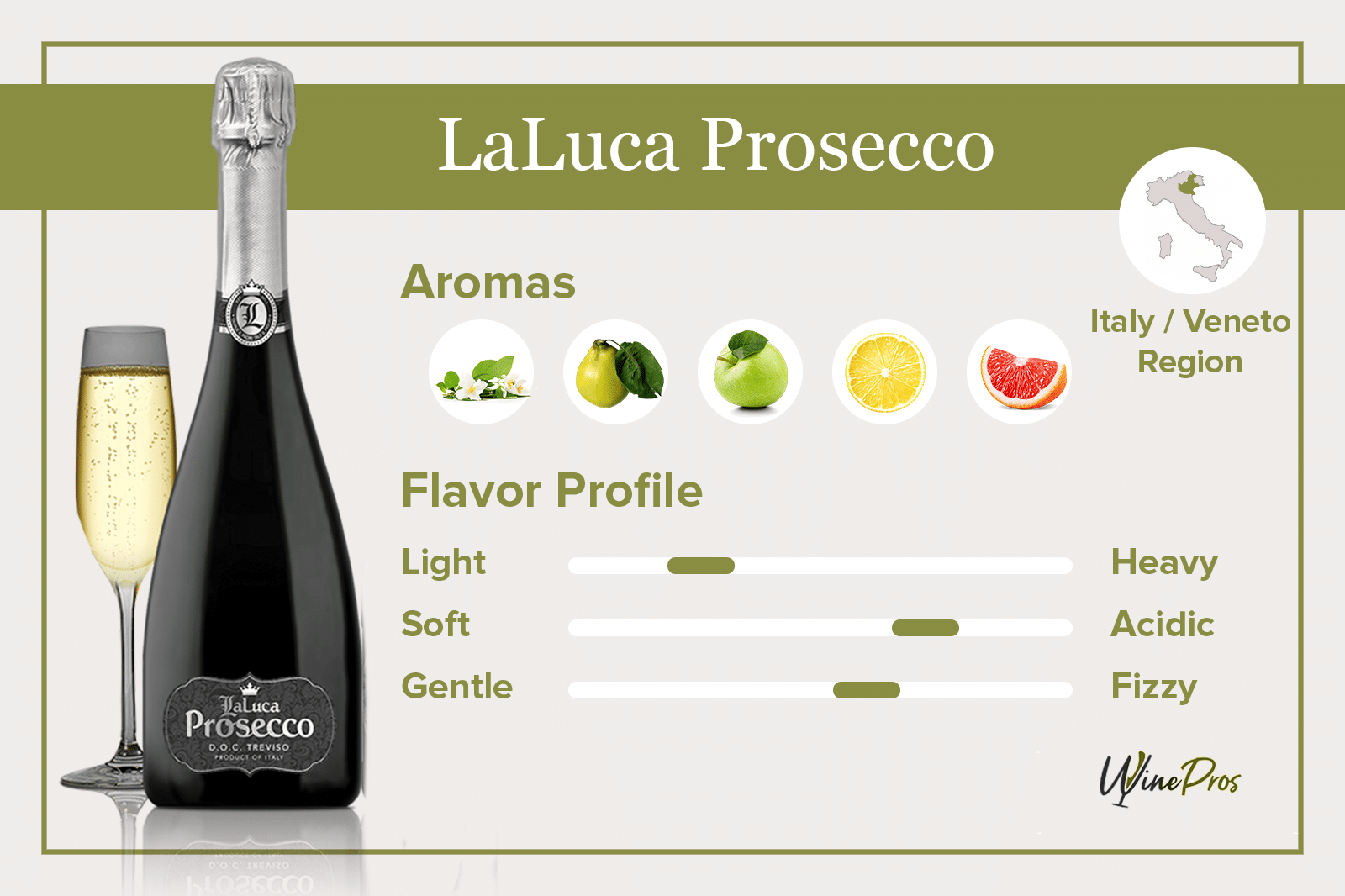What Kind of Wine Is Castello del Poggio Moscato?
Castello del Poggio Moscato wine is a sweet sparkling from Italy. With aromas of white flowers and green fruit, the wine begins its tasting journey delightfully. The frothy palate shows pineapple and peach, citrus, red fruit, and yeasty notes with a smooth, almost velvety mousse. Overall, Moscato d’Asti wines are sweet and have gained popularity among wine enthusiasts in the past few years. They are incredibly fragrant and intoxicating. As a rule, they will always be lower in alcohol but sweeter than the prestigious Champagne.
The town of Asti, located in Northern Italy’s Piemonte region, is the center of the Moscato d’Asti production. On top of that, these wines are renowned everywhere in the wine world for their gentle sweetness and fine mousse, which makes them approachable and enjoyable beyond comparison.
Castello del Poggio Moscato Review

- Winery — Castello Del Poggio
- Country/Region — Italy, Piemonte, Moscato d’Asti
- Type — Italian Moscato d’Asti
- Aroma — Honeysuckle, Orange Blossom, Apple, Pear, Lemon Zest, Musk, Mint, Asparagus
- Grapes — Muscat
- Taste — Pineapple, Peach, Lychee, Mandarin Orange, Strawberry, Plum, Cotton Candy, Brioche Bread, Honey, Wet Straw, Chocolate
- Alcohol Content — 5%
- Sugar — Sweet
- Pairing — Sichuan Beef, Cajun-style Chicken Wings, Thai Cuisine, Ice Cream, Nuts, Blue Cheese
Castello del Poggio Moscato is intense and welcoming, with a delicate palate of musk, peaches, and green fruits. Easy-going and palatable, this bubbly is perfect for fun times by the pool or to be enjoyed at the patio with family. On top of that, the soft mousse is creamy and, at the same time, stimulating, ensuring endless satisfaction. Overall, Castello del Poggio Moscato is a great bang for your buck!
Tasting Notes
The Castello del Poggio Moscato flavor profile is very inviting, with delicate scents of orange blossom, musk, apple, and citrus. On the palate, the wine is sweet but not cloying. It is well-balanced with a very refined fruitiness, full of exotics and brioche bread touches. The mousse is fine and buttery, while the finish is straightforward and clean.
Appearance
The wine’s color is straw-yellow. That is a pleasing appearance and matches perfectly with Castello del Poggio Moscato’s vivid character. Golden reflections are present, too, on the sides, providing beauty and shine. For the most part, the core is transparent. Although, some slight foggy particles can be observed, too. The tears of the wine are medium and watery, supplementing the wine’s appearance nicely.
Aroma
With a pronounced nose of honeysuckle and orange blossom notes, Castello del Poggio Moscato is sweet-smelling. After a few swirls, several green fruits, such as apple and pear, and lemon zest scents unearth, giving substance and elegance to the aromatic bouquet. That said, Castello del Poggio Moscato is everything but one-dimensional, as hints of musk, asparagus, and medicinal herbs combine, offering characteristic depth. Quite a complex nose, then!
Taste
An abundance of exotics and stone fruits flavors define Castello del Poggio Moscato’s palate. Pineapple and peach join lychee and mandarin orange notes, while strawberry, plum, and cotton candy touches bring out excitement. However, the main components in Castello del Poggio Moscato’s mouth are the brioche bread and honey tastes. As to the bubbles, they fine and creamy. The acidity is crisp and refreshing, balancing the sweetness out magnificently.
Finish
Castello del Poggio Moscato concludes the tasting profile with a medium and fresh aftertaste. There are some lingering pineapple and apple tastes to be found, but nothing major. So, this sparkler has a refreshing and delicious finish, satisfying wine enthusiasts. Sometimes, a clean aftertaste, without pronounced flavors and nutty elements, favors Moscato d’Asti wines, as it enables them to remain fresh to the very end.
Rating
Castello del Poggio Moscato is bright and fruity, just as a Moscato d’Asti should be. Quite sweet but balanced. Sipping it is like taking a bite out of a crisp apple and a juicy pineapple. It has a very smooth texture, too, and a gratifying effervescence. As such, Castello del Poggio Moscato is highly recommended to anyone on the lookout for a stimulating and high-quality Italian sweet bubbly!
Castello del Poggio Moscato Food Pairing
As a general rule, the sweetness and low alcohol content of Moscato d’Asti wines make them perfect companions to spicy food. As such, try to combine Castello del Poggio Moscato with hot food, such as Sichuan beef or Cajun-style chicken wings. On top of that, the wine is super tasty when paired with Thai cuisine. Fried rice or a bold, spicy shrimp soup packed with lemongrass, shallots, lime juice, chili, and fish sauce are fabulous pairing choices, too.
The sweet wine is also delicious with ice cream, pancakes, and hazelnut desserts, as instead of using it to balance a salty or spicy dish, you can use it to accentuate a sweet one, too. Last but not least, Castello del Poggio Moscato is superb with blue cheeses, such as Gorgonzola, Oxford Blue, and Stichelton, because these cheeses have pronounced flavors that counterbalance the wine’s sweetness.
Frequently Asked Questions
Who Makes Castello del Poggio Moscato?
Castello del Poggio Moscato is made by Castello del Poggio, in Piemonte, Italy, one of the most prestigious wine regions in the world. It belonged to the noble Bunéis family, taking its name from the ancient medieval fortress, protecting the border of Asti, a powerful Italian commune during the Late Middle Ages. For many centuries, the Knights Templar inhabited the estate and protected the northernmost part of it. Today, this area is known as the Temple Valley.
Since 1699, the estate has produced very aromatic and inviting wines perfect for every occasion and event. Years later, in 1985, the renowned Zonin family acquired the Domaine and revitalized the iconic winery, investing in equipment and technology.
How Is Castello del Poggio Moscato Made?
Castello del Poggio Moscato d’Asti is made with the Asti method. This wine-making process is exclusive to the Piemonte region. The unusual thing about it is that only one alcoholic fermentation is involved.
A base white wine with neutral flavors is produced, at the start. Then, this white wine is chilled and stored away. When required, for the production of a Moscato d’Asti, it is warmed. It is fed into pressurized stainless-steel tanks, and the fermentation begins!
At the beginning of the fermentation, a portion of carbon dioxide is allowed to escape the tank. Immediately afterwards, the tank is sealed to contain the remaining dioxide. Afterward, the fermentation continues until the alcohol level reaches 5-7%, while the pressure, at this point, is 5-6 atmospheres. After a short while, winemakers stop the fermentation by chilling the wine and filtering it to remove yeasts. The final wine is bottled, again under pressure, and goes for sale.
Where Is Castello del Poggio Moscato Made?
Castello del Poggio Moscato is from Piedmont or Piemonte, in northwestern Italy. Sitting at the foot of the Western Alps, the distinctive geographical spot of Piemonte grants it two key features: the hot Mediterranean climate and the cool Alps. Both of said forces contribute to a wide diurnal range, day-night temperature variation, as sunny days combine with cold nights and foggy mornings to produce excellent wine.
The vineyards of the Moscato Bianco, or simply Muscat, grapes are near to the city of Asti. Winemakers in Piemonte, make use of a unique training system to protect the grapes from sunburn. Unlike in the Veneto, where the Pergola system is used, in Piemonte, winegrowers use the Guyot system. It is designed for low to moderate vigor vineyards, encouraging fewer buds and vine growth than other training systems. It also allows air circulation, minimizing the risk of rot.
Italy has a large number of indigenous grape varieties and produces a vast range of wine styles. It is a wine-making region that has made wine for over a thousand years. In Italy, unlike in the New World, the appellation is vital. Hence, science and the role of the winemaker are considered less important in the production of wines.
How to Serve Castello del Poggio Moscato?
Castello del Poggio Moscato is served best in flute glasses. The creamy bubbles and the delicate floral fragrances concentrate into the small environment before they are released and sent rapidly to the top of the glass, exploding on the nose. If flute glasses are not available, standard-sized white wine glasses can suffice. They still help Castello del Poggio Moscato aerate and encourage the release of its sweet-fragrant bouquet.
Moreover, Castello del Poggio Moscato requires chilling before uncorking. Strive to cool the wine for up to 4 hours before serving (40-45°F or 6-8°C). So, grab that bottle, wrap it in a wet paper towel, and place it inside the fridge. Afterward, take it out from the refrigerator and pour the wine to your heart’s content.
But to keep Castello del Poggio Moscato enjoyable, you have to keep it chilled during service. To do so, use an ice bucket. Fill it three-quarters full with equal quantities of ice and water so that iced water surrounds the bottle. The water is then able to transfer the heat from the bottle to melt the ice. Air acts as an insulator, and the bottle chills. Bear in mind, though, that over-chilling overshadows flavors and aromatics in wines.
How Much Does Castello del Poggio Moscato Cost?
Castello del Poggio Moscato is served best in flute glasses. The creamy bubbles and the delicate floral fragrances concentrate into the small environment before they are released and sent rapidly to the top of the glass, exploding on the nose. If flute glasses are not available, standard-sized white wine glasses can suffice. They still help Castello del Poggio Moscato aerate and encourage the release of its sweet-fragrant bouquet.
Moreover, Castello del Poggio Moscato requires chilling before uncorking. Strive to cool the wine for up to 4 hours before serving (40-45°F or 6-8°C). So, grab that bottle, wrap it in a wet paper towel, and place it inside the fridge. Afterward, take it out from the refrigerator and pour the wine to your heart’s content.
But to keep Castello del Poggio Moscato enjoyable, you have to keep it chilled during service. To do so, use an ice bucket. Fill it three-quarters full with equal quantities of ice and water so that iced water surrounds the bottle. The water is then able to transfer the heat from the bottle to melt the ice. Air acts as an insulator, and the bottle chills. Bear in mind, though, that over-chilling overshadows flavors and aromatics in wines.
How Long Does Castello del Poggio Moscato Last?
Wine enthusiasts should consume Castello del Poggio Moscato young within days from bringing the wine back home from the store. As a Moscato d’Asti, the wine does not benefit from bottle aging. On the contrary, by putting the wine away for maturation, you decrease its crispiness and freshness. And while pronounced honey and stewed fruit flavors may develop after extensive bottle-aging, the bubbles fade. That is not good since a Moscato d’Asti should brim with energy and vibrancy. To sum it up, the longer Castello del Poggio Moscato remains uncorked, the worse its dynamic character gets.
How Many Calories Does Castello del Poggio Moscato Have?
Castello del Poggio Moscato is a suitable dietary choice for consumers that are not on a low-carb diet. There are 23 calories in 1 fluid ounce of the beverage, equating to 119 per glass. The calorie breakdown is 0 grams of fats, 5 grams of sodium, 19 grams of total carbs, 0 grams of protein, and 19 grams of total sugars. So, the Castello del Poggio Moscato calories are definitely low. However, the large amount of residual sugar and carbohydrates constitutes this wine an unwise drink choice for those who monitor their calorie intake.
For people interested in Castello del Poggio Moscato alcohol content, it sits at just 5%. That is a typical alcoholic concentration for a Moscato d’Asti, as the low alcohol level enables this wine style to be one of the most enjoyable and popular aperitifs ever created! Also, remember that unless designated on the label, wines are not vegan. During wine-making, wines are clarified through fining, where the most commonly fining agents are animal-based. Vegans, consequently, must consider this before sipping Castello del Poggio Moscato.
Conclusion
Castello del Poggio Moscato is intense and welcoming, with a delicate palate of musk, peaches, and green fruits. Easy-going and palatable, this bubbly is perfect for fun times by the pool or to be enjoyed at the patio with family. On top of that, the soft mousse is creamy and, at the same time, stimulating, ensuring endless satisfaction. Overall, Castello del Poggio Moscato is a great bang for your buck!

